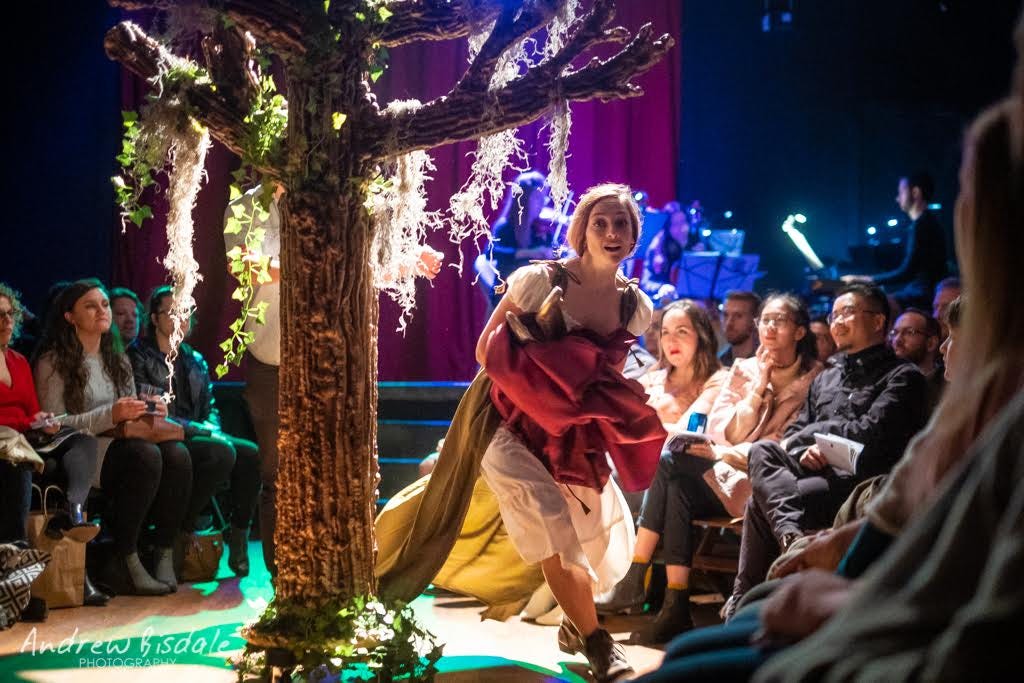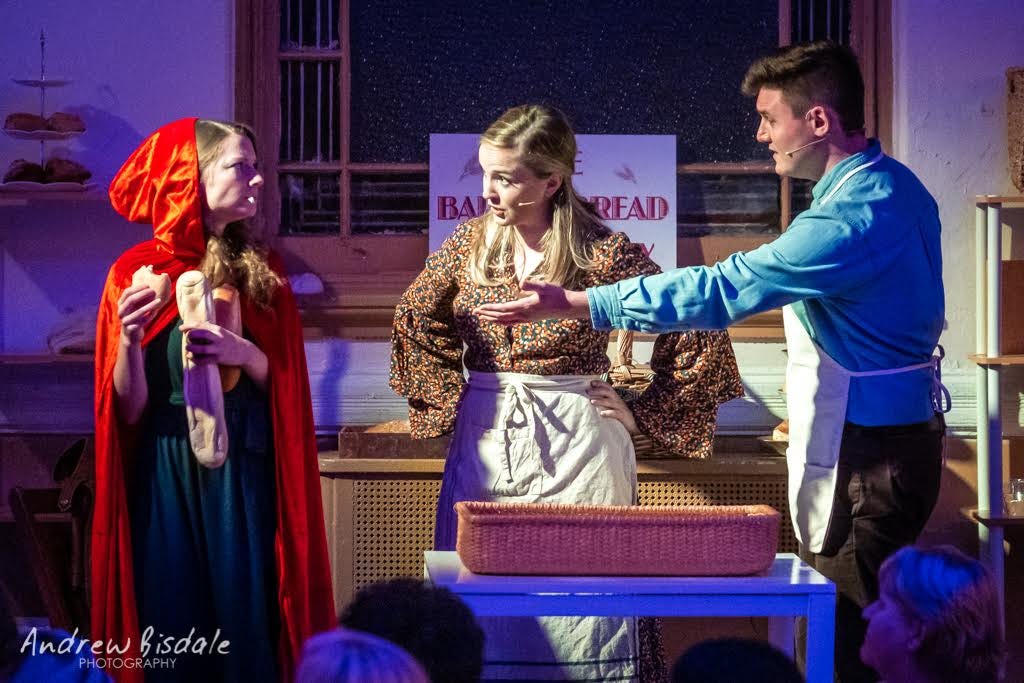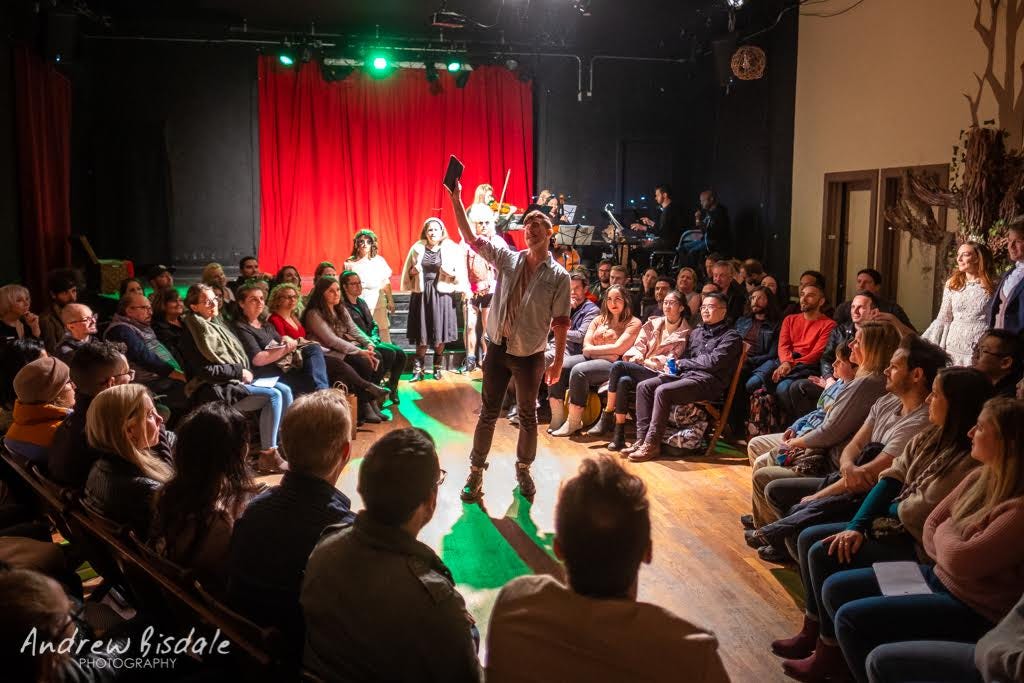
Growing up Catholic, it was always a running joke that Sunday mass was a “workout” with the number of times the congregation stands up and sits back down again. It wasn’t until recently that I realized the same standard held true for immersive theatre set inside a church. Rooftop Musical Society’s immersive spin on the Sondheim classic Into the Woods takes place throughout the two floors of St. Paul’s Lutheran Church of Williamsburg, with the “woods” set in the more traditional stage space upstairs and everything else (the Baker’s house, the castle, and Jack’s house) set in the open room downstairs. Rooftop Musical Society markets the show as unfolding “throughout two floors of a historic church [where audience] members might find themselves having a drink at the tavern with the witch, buying some bread from the Baker, or flirting with royalty, followed by the classic show in an immersive setting.” Considering the company’s goals of creating “pop up immersive theatre in unique locations” to “immerse the audience with word and song in a completely raw, unique, and interactive way” this description seemed to fit the bill, but I was disappointed to find the production unable to live up to expectation.

The audience is first let into the downstairs room which features small vignette-like sets of the bakery, the castle, and Jack’s house on the fringes of the room, with large blankets spread out in the center. The audience is left to mingle with the actors and have a drink at the bar before the show begins. This tactic is a great way to draw audience into the story right away, but is very tricky to sustain, as it sets the tone of what behavior and level of participation can be expected throughout the experience. However, this portion happens before the curtain time of 7:30pm, so any late or right on time audience members will miss it entirely. Even though we were there 20 minutes before curtain, we didn’t get to experience any interactions with the cast; the size of the audience was too large and they just never got to us. Soon, we were told by an actor to move to the other side of the room as that’s where all the action would be happening. We were a bit confused by this, so we pressed for further instructions. Then we were told we could stand anywhere we wished. So we nestled ourselves in a corner between Jack’s house and the castle.
Unfortunately, the blocking of the opening number was clearly created to be viewed from the blankets in the center of the room, so we didn’t see much from our angle. Luckily, after the opening number, the Narrator announced that the show would continue in “The Woods” upstairs, and that it would be open in about five minutes. Intrigued, we followed the crowd up some stairs lit with fairy lights, our hopes high.
“The Woods” is set in St. Paul’s proper theatre space, with a small stage and open floor. Audience seating was set up tennis court-style, but with the chairs angled in to create a diamond shaped stage area on the floor. The musical then continues as expected once audience is seated, until the official intermission between Act I and II. The top of Act II begins in the room downstairs (as called for by the script), and then the audience is ushered up into the woods once again to finish out the show.
Get Allie Marotta’s stories in your inbox
Join Medium for free to get updates from this writer.
SubscribeSubscribe
The idea of placing different scenes in different physical spaces is a great tool for immersive work. In particular, it creates opportunities for movement and story development and also motivates the audience to stay engaged and feel immersed. But the structure just doesn’t work for this production. It ends up feeling like something that was thrown into the concept to be “innovative” and “immersive” as it fails to find a justification as for why the audience keeps moving around. The transition between spaces is clunky and too time-consuming, due to the fact that the live orchestra must move first. The audience is left waiting for the musicians, which creates a de facto additional mini intermission each time. The production as a whole seems to have a disregard for the audience, as evidenced by a jarring lack of guidance and intention behind the audience experience as a whole. This misfire was particularly evident in the show’s attempts to effectively use the space.
Even removing the lens of “immersive” entirely, I found that the basic elements of the production had not been made with the audience in mind. The prioritization of edgy design choices leaves audience members with terrible sight lines and uncomfortable seats.

Although the attempt at immersion was made in the pre-show, that’s where it ends. The rest of the production makes no effort to break the fourth wall and becomes a fully seated, proscenium style show once the pre-show ends (save for the moving of spaces throughout). The audience has no effect on the show which left me wondering why “we” are here to begin with. Even looking at the performance as a non-immersive production, I still struggle to find merit in the production. There was a lack of finesse overall that I found totally disappointing; there were strange directional choices like a male actor playing a female character in “bad drag” as well as unfortunate technical difficulties with microphones. The one thing I can wholeheartedly highlight is the hard work the cast has put into the performance. The entire ensemble is well-rehearsed, bright and energetic, and able to roll with the punches. In fact, a stand out performance by Emily S. Munson as The Witch is what kept me from zoning out entirely.
My experience did bring a question I’ve been wondering about for a while: can a stage musical be made truly immersive without significant changes?
Musicals are written with the intent of filling the proscenium stage and are structured complexly to fulfill that goal. I would say that it is quite difficult to find an immersive thread in an existing stage musical without adapting or cutting, pasting, and splicing scenes and moments together. An “immersive” production of The Wild Party a few years back failed in the same areas that this production of Into the Woods did, leaving the audience seated and creating a “theatre in the surround” production that lacked consideration for audience experience. It’s difficult to find a way to immerse the audience when the material is highly narrative and calls for constant audience attention to follow along, then add in the full ensemble scenes and it’s a pickle to be in.
I wish I had better news to report, and perhaps someday someone will crack the nut of the immersive stage musical, but this production of Into the Woods had me (much like Taylor Swift) wondering if we were out of the woods yet.
Into the Woods has concluded its run.
NoPro is a labor of love made possible by our generous Patreon backers. Join them today!
In addition to the No Proscenium web site, our podcast, and our newsletters, you can find NoPro on Twitter, Facebook, YouTube, Instagram, in the Facebook community Everything Immersive, and on our Slack forum.
Office facilities provided by Thymele Arts, in Los Angeles, CA.



















Discussion